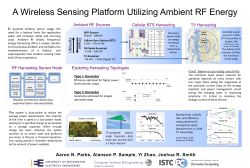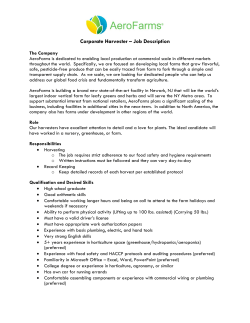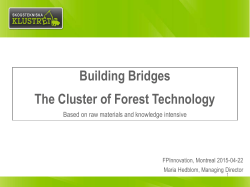
transcript - Case IH Step UP! 2015
1 17th March 2015 Case IH Step UP! 2015 Michael Camilleri Our technology, our machines, is part of our humanity. We created them to extend ourselves, and that is what is unique about human beings. – Ray Kurzweil, Director of Engineering at Google I am Michael Camilleri, second generation farmer, owner and founder of Maalacan Engineering (which has been in operation for over 35 years now), qualified boilermaker, ACFA board director, and fellow sugar enthusiast. I have devoted my life to the sugar industry and in the process developed a passion for engineering. I have garnered a reputation from my peers for doing the difficult things well, whether that be machining elaborate components or developing specialised farm and harvester equipment. But it all started with my father. He was a migrant Maltese, drawn to the opportunities Australia had to offer in a time where land was scarce and money was hard to come by. I was his youngest child with two brothers and two sisters, and some of my earliest memories were of growing sugar cane. I left school half way through Grade 10 in 1969 and started work with my brothers on our family farms. At that time wages were about $10 a day, we could buy diesel for 17c per gallon and tractors were still made in Australia. Kerosene tractors were still in use back then so the new diesel tractors proudly displayed diesel on their badging; at a glance you could see this was a tractor of the future. Mechanical harvesting was still in its primitive stages. We had just purchased a DMH 5 Don Mizzi and, in the marginal country we farm, it was a huge improvement from the Massey Ferguson 515 we had been using since 1964. My eldest brother Joe drove the harvester and middle brother Frank worked the farms. Being the youngest I worked where I was told but my heart lay in working with the harvester. I enjoyed the high energy of working in a team to fill the bins and then working on the machine to keep it going. At least 25% of your time was spent burning for the following day and maintaining the harvester to ensure it wouldn’t let you down during the next day’s harvest. In those times, we harvester operators were always busy crafting ideas to improve the harvester’s performance. It was common to network with as many harvesting operators in your area as you could, to discuss problems encountered and possible solutions; and if you thought you might have enough knowledge and tools to set about modifying the harvester, you would muster up the courage and give it a go. Then sometimes after trying, you discovered that you weren’t capable of pulling it off and the situation was now worse than it was initially. 2 Consequently, the farm workshop began. First the welder, which led to the oxy torch – I still have vivid recollections of my eldest brother cutting steel by turning the welder up flat out and burning through it with the welding rod. As time went on, we began to tackle more intricate problems, and the need to purchase tools continued. Next came the drill, then the lathe and the milling machine, and then bigger welders and so on. It’s amazing what gets driven by efforts to solve problems. That’s how REEFA, our Responsible Economical Environmental Fertilizer Applicator came to be. My brother-in-law, concerned with protecting the reef-water quality, came to me one day and said: “Why don’t you build me a coulter that works in red soil.” My first thought was why do I have to build it, why can’t somebody else do it. Everybody knows coulters with tynes don’t work very well in red soil but he kept insisting. What I did then was research the various styles of coulters available, and by talking with the operators and listening to what difficulties they have faced, I conceived ideas to solve them. Maalacan’s first coulter was a single row and it has worked very successfully. The next machine we built was a standard fixed coulter, for myself, over 3 rows. However, in the undulating country, the disc on the top side of the hill would be out of the ground, the middle one would be in the ground, and the bottom one would be burying. When the disc fails to maintain an optimal depth it starts dragging trash, among a host of other issues, and cannot bury the fertilizer, which is the whole point of the operation, getting the nutrient under the surface of the soil. To make REEFA the successful machine that it is, especially when operating in both red soil and marginal country, I made a multitude of adjustments: The rear axle is set up on a slide and can be adjusted to any row width from 1.5-2 metres The coulters are set up on a hydraulic sliding toolbar to accommodate varying row widths and pull in for road travel You can lift the machine from the rear and the front, or whichever you prefer, allowing the operator to work at any desired angle - you can work with it tilted forward or tilted back The hydraulic draw bar is designed to turn the bin 90 degrees to the tractor, enabling tight turns All height settings can be infinitely adjusted by turning a threaded arm, you aren’t restricted to pin hole positions And my favourite, the parallelogram suspension on the coulter allows each disc to individually follow the ground surface which is governed by a gauge wheel and jump rocks or follow through washouts. The bin has been designed with steep sides to prevent the fertilizer from clumping to the walls of the bin The drive is controlled by GPS and can change fertilizer rates at the touch of a button, you can drive at whatever speed you desire and still maintain pre-set fertilizer rates 3 And we fit a hydraulic lid for easy filling Just look how well it performs.. watch video After I finished contract harvesting, I moved into the machine shop to expand into the technically intricate areas required to meet the ever increasing demands for farming and harvesting technology. I actually had to do the engineering professionally, to be able to afford the high tech machinery for the workshop, and to do that I had to develop it into a business that could stand on its own two feet without being supported by the farm. In 1978 I registered Maalacan Engineering, which today carries out intricate machining operations, ranging from industrial castings for other manufacturers, to farm and harvesting equipment. I have always strived to improve my engineering workshop to allow us to build more technologically advanced equipment. It has been gradual and continual growth. For example, we purchased the CNC machines between 1990 and 2000 to keep up with the ever increasing demand, spending approximately 1 million dollars on tooling during that time. It is only natural to evolve when you have a desire to do good things. I get excited when I carve a new profile out of a plain piece of steel; when you begin with a raw piece of metal, start machining, and see all this metal flying off. It becomes intricate and valuable. I guess you could say I get excited about value adding. The thing with value is that it doesn’t always correspond to an immediate monetary figure. When you own a farm, you don’t make a lot of money and if you run a farm purely on the basis of earning money you will get disappointed. Farming in Australia has to be executed with a long term view. Most successful farms are multi-generational, I know I would not have been able to achieve what I have, without the platform my father left me because my father held a long-term view. Good machinery is expensive, it is important it lasts a long time. If you’re going to build a new piece of equipment or correct a paddock, the initial cost doesn’t instantly amount to the financial return, it may take 10 years to recover the cost. You must also take into consideration the time you will save and the ease in which you will complete your work. Nobody calculates the cost of lost production time because you didn’t fix a problem before you started. Once you remove a problem it frees your mind to focus on the more valuable objectives. Being able to look ten years into the future and see the results of taking action now, gives you the ability to stretch yourself. Of course you still have to make the money work today, but it is very easy to lose sight of where you are going because of the hardship at present. With this type of thinking there is no room for complacency, because complacency breeds laziness, and laziness breeds difficulty, and in an instant your whole outlook can change to ‘it can’t be done’. One of the biggest problems with industry in Australia is the belief that someone else should do it. It is one thing to point your finger at others, saying they should change this or do that, but when you step 4 back and look at what you can do, you gain access to an extremely resourceful state. When you focus on the things you can change, not the things you can’t, it suddenly makes something that wasn’t possible, possible. Planting on hill sides, for instance, has always been a problem because it is incredibly difficult to maintain an even row spacing while keeping the row straight. A conventional tractor and planter doesn’t want to stay where you position it. By focusing on the possibilities, my brother Joe designed and built a self-propelled, double-row track planter. With the assistance of one man, Joe can easily plant 20 acres a day on the side of what most people would call a mountain. After working with his father, Joe’s son Gabriel has taken it one step further. I tease him about being a traitor to the family tradition because Gabe believes he has seen the light and moved to flatter country. Gabe’s planter is fully controlled by GPS, it has guidance, and the fertilizer, Suscon, and elevator chains are all controlled by GPS with the ploughs and wheels set up on hydraulic slides. By removing a pin and activating a hydraulic cylinder Gabe can easily set his planter to suit any row spacing, and at the touch of a button he can control the rate of cane per hectare, fertiliser and Suscon to give the customer exactly what they want. This I believe is state of the art technology. However, when we were building the planter, I wasn’t convinced that the GPS technology would be so successful. I used to tease Gabe that – I’m going to town to buy a coil of chain just in case the GPS doesn’t work. But it does work. Brilliantly. I dream of a day when GPS-controlled UAV drones equipped with infrared cameras can fly over our fields and map the differing crop conditions, so that we can feed this information into our fertilizer and planting equipment and apply specialised nutrients to separate portions of the field according to the yield. Now this technology is already available and it’s part of a trend toward data-driven agriculture to grow more food with less labour. It’s incredibly exciting to know, that with all the new technology available, we’re going to do things we haven’t even thought of yet.
© Copyright 2025








